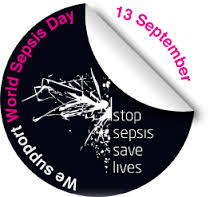Sepsis is a rare but serious complication of an infection.
Without quick treatment, sepsis can lead to multiple organ failure and death.
Sepsis symptoms in children under five
Go straight to A&E or call 999 if your child has any of these symptoms:
looks mottled, bluish or pale
is very lethargic or difficult to wake
feels abnormally cold to touch
is breathing very fast
has a rash that does not fade when you press it
has a fit or convulsion
Get medical advice urgently from NHS 111
If your child has any of the symptoms listed below, is getting worse or is sicker than you’d expect (even if their temperature falls), trust your instincts and seek medical advice urgently from NHS 111.
Temperature
temperature over 38C in babies under three months
temperature over 39C in babies aged three to six months
any high temperature in a child who cannot be encouraged to show interest in anything
low temperature (below 36C – check three times in a 10-minute period)
Breathing
finding it much harder to breathe than normal – looks like hard work
making “grunting” noises with every breath
can’t say more than a few words at once (for older children who normally talk)
breathing that obviously “pauses”
Toilet/nappies
not had a wee or wet nappy for 12 hours
Eating and drinking
new baby under one month old with no interest in feeding
not drinking for more than eight hours (when awake)
bile-stained (green), bloody or black vomit/sick
Activity and body
soft spot on a baby’s head is bulging
eyes look “sunken”
child cannot be encouraged to show interest in anything
baby is floppy
weak, “whining” or continuous crying in a younger child
older child who’s confused
not responding or very irritable
stiff neck, especially when trying to look up and down
If your child has any of these symptoms, is getting worse or is sicker than you’d expect (even if their temperature falls), trust your instincts and seek medical advice urgently from NHS 111.
Sepsis symptoms in older children and adults
Early symptoms of sepsis may include:
a high temperature (fever) or low body temperature
chills and shivering
a fast heartbeat
fast breathing
In some cases, symptoms of more severe sepsis or septic shock (when your blood pressure drops to a dangerously low level) develop soon after.
These can include:
feeling dizzy or faint
a change in mental state – such as confusion or disorientation
nausea and vomiting
slurred speech
severe muscle pain
severe breathlessness
less urine production than normal – for example, not urinating for a day
cold, clammy and pale or mottled skin
loss of consciousness
When to get medical help
Seek medical advice urgently from NHS 111 if you’ve recently had an infection or injury and you have possible early signs of sepsis.
If sepsis is suspected, you’ll usually be referred to hospital for further diagnosis and treatment.
Severe sepsis and septic shock are medical emergencies. If you think you or someone in your care has one of these conditions, go straight to A&E or call 999.
Tests to diagnose sepsis
Sepsis is often diagnosed based on simple measurements such as your temperature, heart rate and breathing rate. You may need to give a blood test.
Other tests can help determine the type of infection, where it’s located and which body functions have been affected. These include:
urine or stool samples
a wound culture – where a small sample of tissue, skin or fluid is taken from the affected area for testing
respiratory secretion testing – taking a sample of saliva, phlegm or mucus
blood pressure tests
imaging studies – such as an X-ray, ultrasound scan or computerised tomography (CT) scan
Treatments for sepsis
If sepsis is detected early and hasn’t affected vital organs yet, it may be possible to treat the infection at home with antibiotics. Most people who have sepsis detected at this stage make a full recovery.
Almost all people with severe sepsis and septic shock require admission to hospital. Some people may require admission to an intensive care unit (ICU).
Because of problems with vital organs, people with severe sepsis are likely to be very ill and the condition can be fatal.
However, sepsis is treatable if it is identified and treated quickly, and in most cases leads to a full recovery with no lasting problems.
Read more about treating sepsis.
Recovering from sepsis
Some people make a full recovery fairly quickly. The amount of time it takes to fully recover from sepsis varies, depending on:
the severity of the sepsis
the person’s overall health
how much time was spent in hospital
whether treatment was needed in an ICU
Some people experience long-term physical and/or psychological problems during their recovery period, such as:
feeling lethargic or excessively tired
muscle weakness
swollen limbs or joint pain
chest pain or breathlessness
These long-term problems are known as post-sepsis syndrome. Not everyone experiences these problems.
Read more about recovering from sepsis on the UK Sepsis Trust website.
Who’s at risk?
There are around 123,000 cases of sepsis a year in England. Around 37,000 people die every year as a result of the condition.
Anyone can develop sepsis after an injury or minor infection, although some people are more vulnerable.
People most at risk of sepsis include those:
with a medical condition or receiving medical treatment that weakens their immune system
who are already in hospital with a serious illness
who are very young or very old
who have just had surgery or who have wounds or injuries as a result of an accident
Read more about the causes of sepsis.



